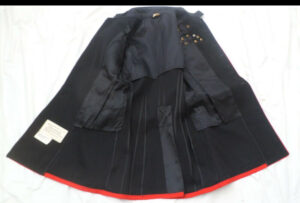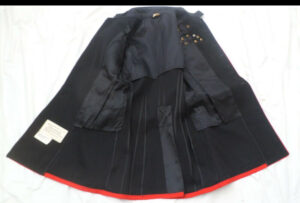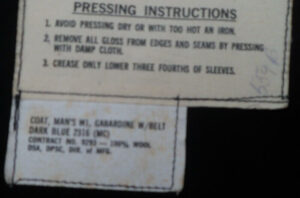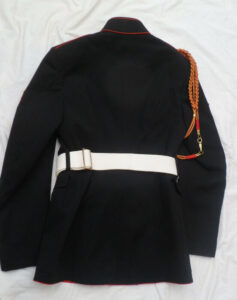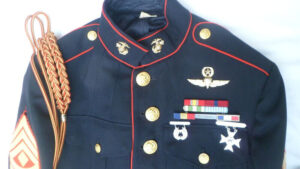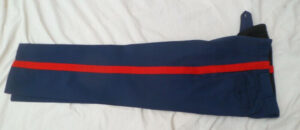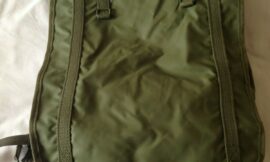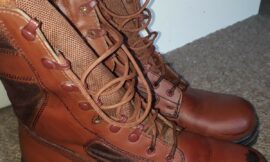The United States Marine Corps Dress Blues uniform, often referred to simply as “Dress Blues,” is one of the most iconic and recognizable military uniforms in the world. It is steeped in tradition and symbolism, reflecting the honor, history, and pride of the Marine Corps. Here’s an in-depth look at the components, history, and significance of the Marine Corps Dress Blues uniform.
Components of the Dress Blues Uniform
Blue Dress “A”
- Coat: Dark blue with a standing collar, red piping, and gold buttons featuring the Eagle, Globe, and Anchor (EGA) emblem.
- Trousers: Sky blue with a red “blood stripe” for NCOs, SNCOs, and officers, which represents the blood shed by Marines in the Battle of Chapultepec during the Mexican-American War.
- White Belt: Worn with the coat, featuring a gold buckle.
- Cover: White peaked cap for officers and SNCOs, and a white barracks cover for other ranks.
- Accessories: White gloves, black dress shoes, medals, and ribbons.
Blue Dress “B”
- Coat: Same as Blue Dress “A.”
- Trousers: Same as Blue Dress “A.”
- Accessories: Ribbons and shooting badges instead of medals.
Blue Dress “C” and “D”
- Blue Dress “C”: Blue coat removed, long sleeve khaki shirt worn with the same trousers.
- Blue Dress “D”: Blue coat removed, short sleeve khaki shirt worn with the same trousers.
Historical Significance and Symbolism
Blood Stripe
The red stripe on the trousers of NCOs, SNCOs, and officers is known as the “blood stripe.” It commemorates the bravery and sacrifice of Marines who fought in the Battle of Chapultepec in 1847 during the Mexican-American War. The blood stripe is a symbol of the Marine Corps’ proud heritage and its tradition of valor.
Eagle, Globe, and Anchor (EGA)
The EGA emblem, featured prominently on the uniform’s buttons and cover, represents the Marine Corps’ commitment to service on land, at sea, and in the air. The eagle signifies the nation, the globe represents worldwide service, and the anchor symbolizes naval traditions.
Colors
- Dark Blue: Reflects the Corps’ naval heritage and its connection to the Navy.
- Scarlet: Symbolizes the blood shed by Marines in battle.
- White: Represents purity and commitment to duty.
Evolution and Changes
Early Development
- Revolutionary War Era: The earliest Marine uniforms were green and white, reflecting the customs and styles of the Continental Marines.
- 19th Century: The transition to the dark blue coat and sky blue trousers occurred, along with the introduction of red piping and the standing collar.
20th Century to Present
- Post-World War II: The modern Dress Blues were standardized, incorporating elements from earlier uniforms while adapting to contemporary needs.
- Modern Updates: Although the fundamental design has remained consistent, minor updates have been made for practicality, comfort, and alignment with current standards.
Wearing the Dress Blues
Formal Occasions
The Dress Blues are worn for a variety of formal events, including:
- Ceremonies
- Parades
- Official receptions
- Marine Corps Birthday Ball
Daily and Less Formal Wear
Variants such as Blue Dress “C” and “D” are used in less formal settings, including:
- Office environments
- Daily duties
- Informal ceremonies
Pride and Tradition
The Marine Corps Dress Blues uniform is more than just attire; it is a symbol of the pride, discipline, and heritage of the Corps. It serves as a visual representation of the Marines’ commitment to their values and their storied history. Wearing the Dress Blues instills a sense of pride and belonging among Marines, reminding them of their duty and the sacrifices of those who came before them.
Conclusion
The United States Marine Corps Dress Blues uniform is a distinguished and revered symbol of the Marine Corps’ legacy. Its design, rich with historical significance and symbolism, honors the valor and dedication of Marines past and present. Whether worn during formal ceremonies or in daily service, the Dress Blues reflect the honor, courage, and commitment that define the United States Marine Corps.

